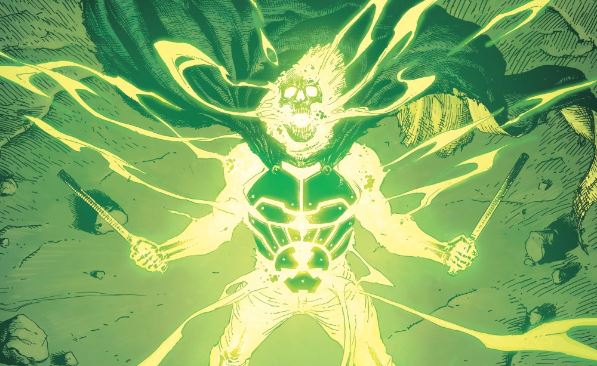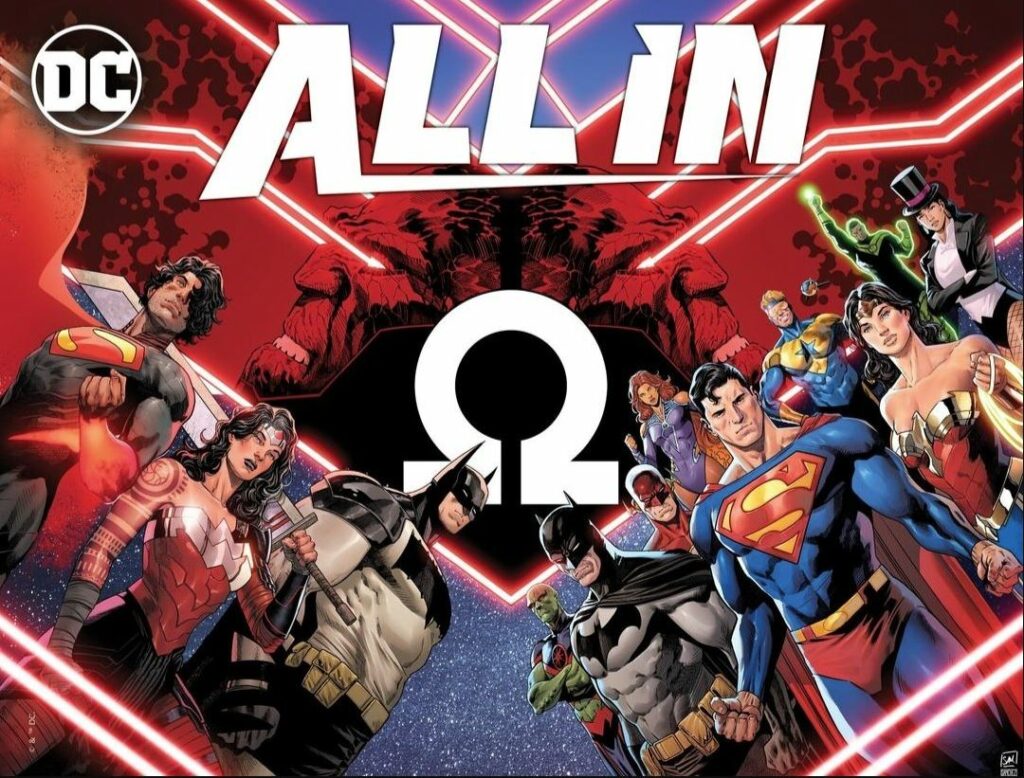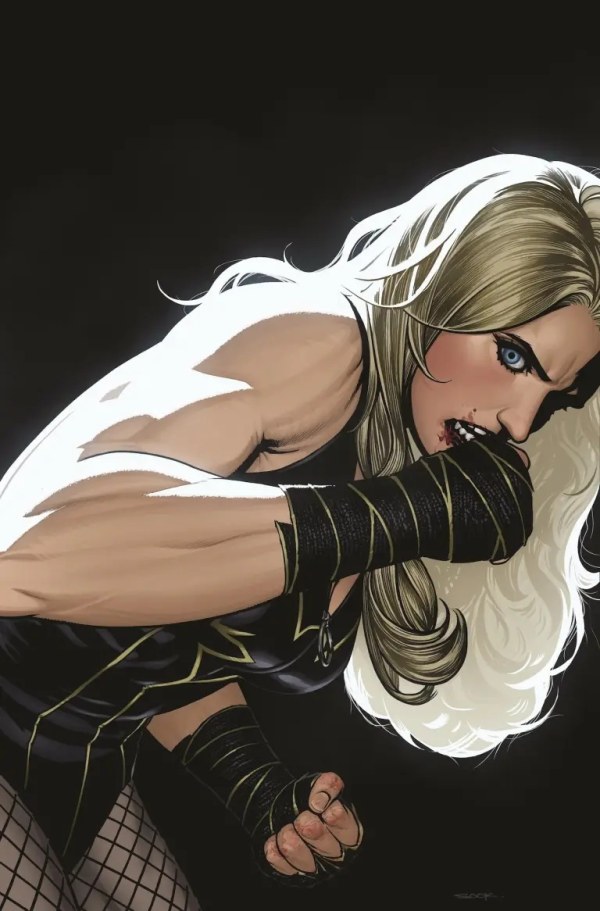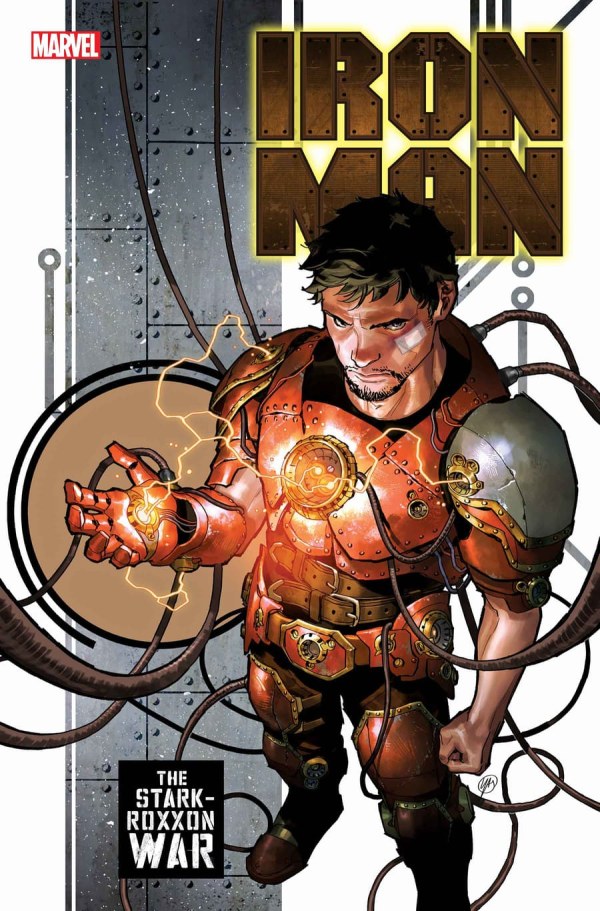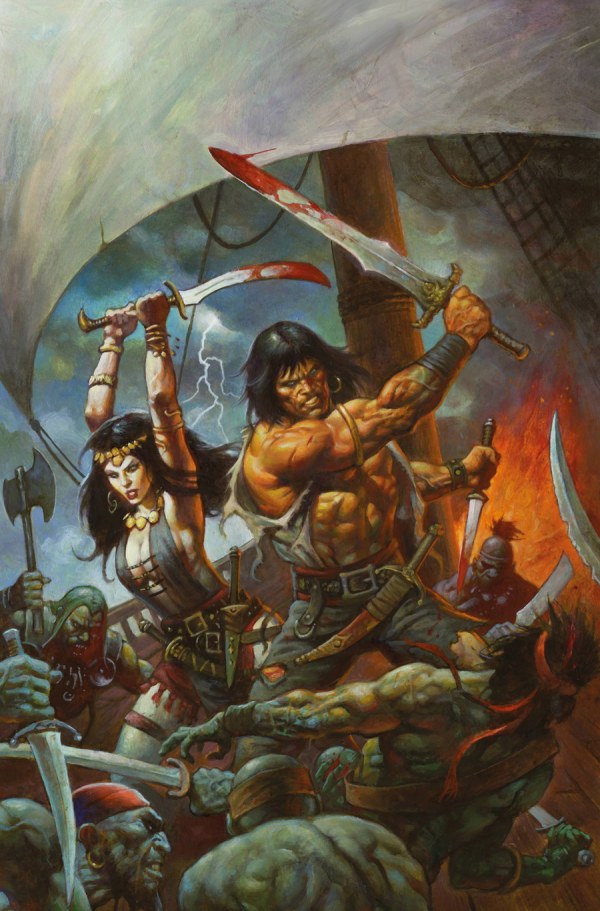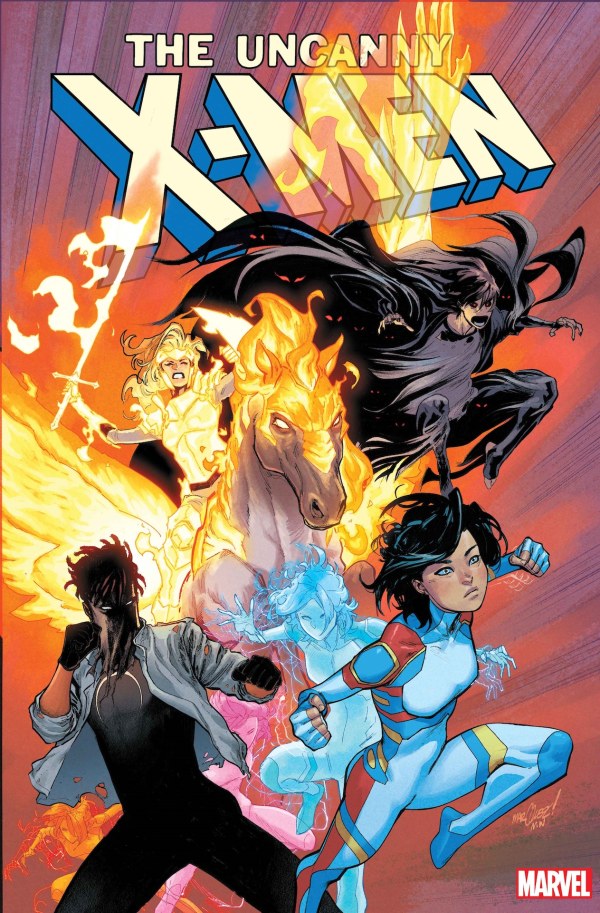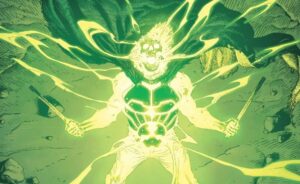Secret origins are no stranger to comics, least of all Silver Surfer: Ghost Light #2. Often, in order to tell new stories, writers have to return to the past – a new past, or version of it; one of their own creation – so that they can substantiate the narrative present.
Examples of this are countless. Whether it’s the revealed secrets of resurrections for characters thought long dead, like Jason Todd or Bucky Barnes, or the wholesale reconfiguring of continuity from decades prior. This is the case for characters like Jon Kent who, through various retcons and reality-shifting events, has now always been there, somewhere just off to the side of the panel.
Regardless of the application, comics have been finding new ways to convey exposition like this since their inception. In this issue of Silver Surfer: Ghost Light, John Jennings and Valentine De Landro set out to do two things. One, explain to readers how Al Harper – first and last seen sacrificing himself in Silver Surfer #5 (1969) – is not only not dead, but has in fact become a cosmically powered super-entity (the titular Ghost Light). And two, to find a way to of doing that without playing all the same old notes as decades of comics prior.
The result is Jennings and De Landro employing two similar, but very different types of exposition to convey this new backstory, while also revealing the complicated relationships between narrative and trauma that underpins the act of remembering.
Mythology in Mural
In the first instance, Norrin Radd, the Silver Surfer, recounts to the Harper family the life of Al from a biographical perspective.
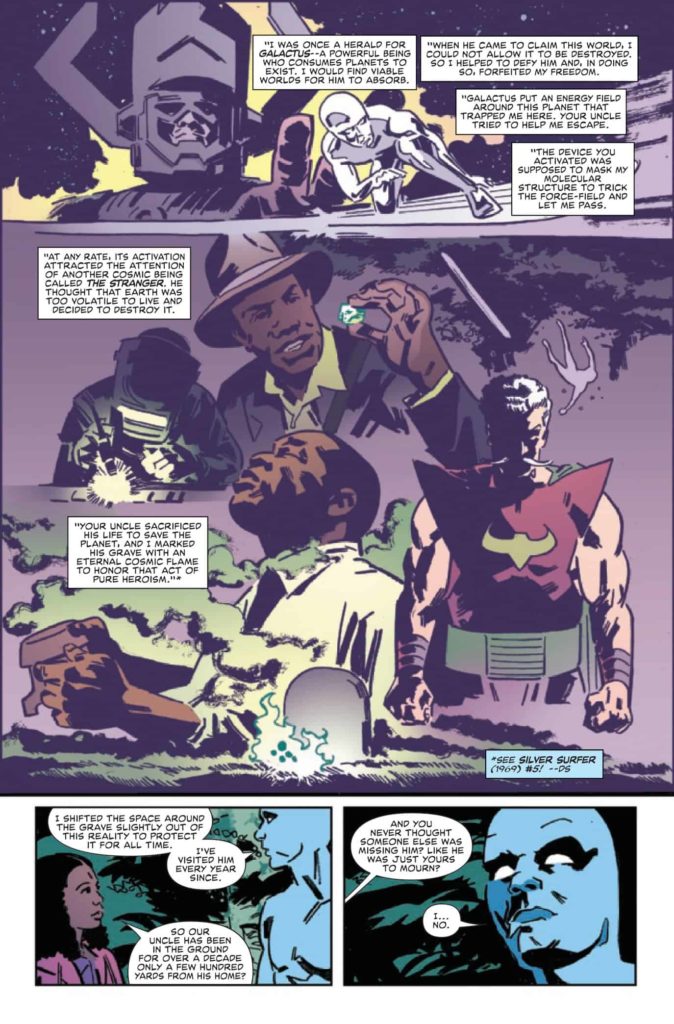
Focusing on this initial use of exposition, it’s clear that Norrin’s account is something of an oral history, fulfilling all the typical objectives of exposition while also elevating what might otherwise be a standard-fare info dump. The reader is quickly brought up to speed both on Al’s relationship with the Silver Surfer, while also covering any key, relevant events in the prior decades on continuity.
However, this information is presented as such to achieve more than just create an accessible entry point for new readers. The Silver Surfer recalls events in a way that is almost theatrical, reciting this narrative of Al’s ‘act of pure heroism’ in a way that more closely evokes the tone of Greek epics more than it does a pained reminiscence. Jennings has the Silver Surfer mythologise his friend and partner, redefining his death not as a tragedy but instead recontextualising it as a heroic sacrifice.
As much as this is a painful memory for him, Norrin presents it to Al’s niece (and by extension the reader) not as trauma but as a story.
At first, this can read as almost cold on Norrin’s part, as if he’s so removed from humanity that he cannot see the tragedy in his life, and instead only sees it as a heroic event in the ever-unfolding tapestry of life. This reading is supported by De Landro’s presentation of events in a mural-like fashion, with images of Al depicted in highly dramatised, almost romanticised ways. Silver Surfer is not reflecting traumatic reality; instead, it seems as though he is trying to “elevate” his passing into something meaningful.
Yet while this may be true of how this exposition appears, there is also a second reading: one that asserts that the Silver Surfer’s mythologisation of Al’s death is not, in fact, a failure of humanity but an abundance of it.
Scott McCloud has talked extensively about the nature of the “gutter” in comics – that is, the white space between the panels. At once a separator and a connector, the gutter is important in that it takes the singular moments either side of it, and allows for imagination to fill in the relationship between the two. Typically, this blank space symbolises the passage of time, as one panel transitions to the next. Additionally, it can allow the reader the opportunity to assess not just the temporal relationship between images, but also the thematic and subtextual relationship between them too – the unspoken language within comics.
What’s interesting about this muralised depiction of Norrin’s oral history of Al Harper is that it eschews the gutter, and in so doing denies the space for the imagination to start drawing connections (or as McCloud would put it, finding ‘closure’). In one sense it denies that experience for the reader, as the page begins to teach you how to read its approach to history. In another, it’s also a visual representation of the denial the Silver Surfer is placing upon himself.
In this light, Jennings’ and De Landro’s use of exposition is not serving to convey Norrin Radd’s coldness, but his need to cope. He chooses to mythologise his friend, not because trauma is alien to him, but because it is all too familiar, and he has developed a way of putting distance between himself and it. Such is the linguistic power of storytelling that the creative team are gesturing at, both spoken language and visual language – the ability to alter emotional realities.
This is not, then, the actions of a cold man, but a wounded one, making selfish (if not understandable) decisions to protect himself. The bottom two panels on the page highlight this. This beautiful, fluid imagery is interrupted by the inflexible rigidity of both panel structure and the truth. ‘You never thought someone else was missing him?’ Toni asks of the Surfer, ‘Like he was just yours to mourn?’. Norrin is forced to confront one aspect of his selfish approach to coping, all while the nature of the page draws the reader’s attention to another.
As such, Jennings and De Landro utilise oral history, murals and panel composition to elevate exposition – taking it from a utilitarian tool to a lens through which the reader can re-examine the source of exposition themselves.
Enter, Ghost Light: A Survivor’s Testimony
The second key instance of exposition in Silver Surfer: Ghost Light #2 comes later in the issue, as Al Harper gives a first-hand account of the events of his “death” to his family.
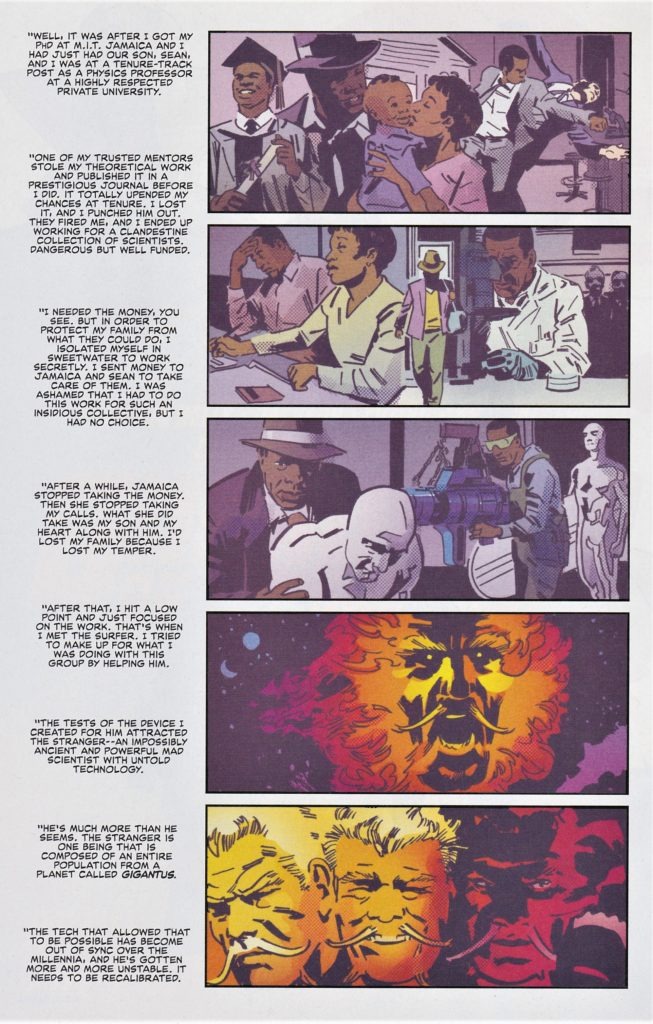

The most immediate point of difference between this and the prior scene is shift in perspective. One is biographical, the other autobiographical, and this holds significance outside the obvious change in perspective. By approaching exposition in two different ways within pages of each other, it calls into question not just the perspective but the distance implicit in both passages. If one is closer to the experience, is it closer to the truth? Al Harper’s survivor testimony is certainly a fuller picture of events, before, during and after, but is that the same as being more objective?
What appears to be a simple change in perspective actually gives way to important questions around the validity of a perceived emotional reality. As mentioned above, the Silver Surfer may have mythologised Al’s death, but he did so to arguably take control of the emotional reality he was presented with. Al Harper’s account is true to his experience, but despite being closer to events it does not make Norrin’s experience any less true.
In this way, the differences in expository technique help shine light on the similarities between their intended effects – testaments to the power of memory to (re)construct the present. It’s not accidental that Al Harper finally escapes the machinations of The Stranger by focusing in on the memory of his niece, Toni. The rediscovery of love through memory has the potential to save us, whether it’s from the guilt of those very memories themselves, as depicted through the Silver Surfer, or from forces entirely independent of our own agency, as depicted here.
The Power Cosmic vs The Power of Comics
Another interesting contrast in the use of exposition in Silver Surfer: Ghost Light #2 comes not in its positioning, but in its composition. There are myriad differences between the passage in question and Norrin’s exposition pages prior: the re-introduction of the gutter and the subsequent creation of separate images as opposed to the fluid, tapestry-like representation of history seen earlier; the utilisation of narrative captions and even the increase in page real estate.
Taking that last point first, there’s an interesting point about the expansion of the narrative when it’s told by its subject. The free-flowing nature of how the Silver Surfers imagines the sacrifice of Al Harper is deceptive, in that the presentation of its content inside the panel distracts from its containment within that same unit of storytelling. Yes, Norrin is mythologising his friend’s life, but he’s also keeping it locked within this one frame – this one idea of what it could have represented. In contrast, Al’s own recollections are of numerous key moments, each significant in their own way, each separate from one another. His life (and presumed death) was never one thing and, unlike the Silver Surfer, he is able to confront the parts worth celebrating without dressing up the pain.
Jennings and De Landro practically invert their use of exposition here, seemingly performing the same narrative manoeuvres while actually demonstrating just how different the coping mechanisms of these two men are.
Al Harper is able to reconcile the things that have happened to him, as he narrates his secret origins in a much more grounded, frank way than his friend previously eulogised him. It’s a highly structured account, in keeping with his profession as a physicist, and this is reflected in the consistent use of panelling. Al takes an almost scientific approach to remembrance, detailing each step on his path to becoming Ghost Light. It’s so scientific however, that it can be read as cold.
This brings Al’s exposition back into contrast with the Surfer’s. The best writers understand that stories have to teach their readers how to read them; here, Jennings and De Landro have already used exposition to teach the audience how to read coldness – not as an alienation from humanity, of pain, but a deep familiarity with it. Whereas the Surfer’s perceived coldness was as an attempt at abrogating the tragedy from Al’s “death”, Al’s own coldness is, I believe, a manifestation of a common response to trauma – the need to intellectualise one’s own emotions so that they can be view from a psychologically safe distance. In this way, Al positions himself as an observer, almost another reader alongside us, viewing his trauma from the outside in.
This couldn’t be clearer than in letterer Joe Sabino’s placement of the narrative captions. Unlike Norrin’s narration – situated within the epic tapestry, where he feels safest – Al’s is relegated to the gutter, outside the events the reader is made privy to. A similar technique is used in Conan the Barbarian #0 (2023) to convey the sense that the protagonist is displaced within their own narrative – in this case, by their own doing. This shows two things: first, exposition can be used to illustrate not just the existence of a tragic backstory, but through its presentation comics are uniquely capable of rendering the emotional distance between characters and said tragedy through page composition. Second, this use of exposition underscores how both characters, not just the Silver Surfer, narrativise their trauma, with the difference in tone between them being key.
Where the Silver Surfer creates mythology, Ghost Light offers survivor testimony. Norrin’s tone is elevated, dramatising; Al’s is clinical. It mirrors another common symptom of those who’ve suffered immense trauma – a loss of affectation. Al Harper may have approached things scientifically as a matter of course, but the man now known as Ghost Light no longer possesses the emotional resources to view things in any other way.
Al Harper Resurrected – The Living History of a Dead Man
The culmination of all these ideas about the intersections of trauma, narrative and denial play out in a blink-and-you’ll-miss-it line:
‘I’d lost my family because I lost my temper’
Al Harper, Silver Surfer: Ghost Light #2
Al’s referring here to the consequences he suffered as a result of increased self-isolation, pushing his family further and further away to keep them safe while he did research for some unsavoury types – a situation he was in because he assaulted a mentor that had stolen his work.
This line calls to mind an all-too-familiar stereotype, the “angry black man”, and in so doing rewrites the racist epithet in a way that no longer denies Al agency over his own actions. He’s not predisposed to violence, he’s a family man who, for a brief moment, lost restraint. He’s not some one-dimensional caricature of aggression either; he’s a protector, a provider, a man capable of great heroism and of being ‘ashamed’. Exposition, in this light, is not just a tool for the textual narrative at hand – it’s a powerful technique capable of recontextualising real world experiences through fictional ones, and placing agency back into the hands of those whose stories have historically not been theirs to tell.
In order to achieve this through Al’s exposition, it is vitally important that Jennings and De Landro frontloaded Silver Surfer: Ghost Light #2 with that of Norrin’s perspective. This is not because it is more significant, but because the team successfully establish one view of history before expanding on that with the voice of someone who it actually centres upon, allowing them to interrogate the reader’s understanding of said history.
Returning to the examination of the gutter, the idea of removing the space in which imagination and closure can interject takes on new meaning when considered alongside Al’s testimony. In its own context, Norrin’s mythologisation of Al’s life is one born out of love and pain, and is meant to elevate who he was. Taken in the context of Al’s wider, multi-dimensional reflection on his life however, Norrin’s actions have some unfortunate consequences. Despite the best of intentions, Norrin’s inability to grapple fully with the tragedy of Al’s perceived death also prevents him from representing that tragedy inherent in his life. He is, in Norrin’s recollection, only a heroic figure, never just a man.
By erasing the gutter, and the psychological space that it represents where the traumatic subtext would reside, the Silver Surfer has whitewashed Al’s backstory. He is not reduced to an “angry black man” in Norrin’s worldview, but he’s not much of a man either. He doesn’t get to author his own thoughts on his pain, nor is there a reckoning with the past, good and ill. Al’s reimplementation of them serves not just to fracture the images of his past, mirroring the fracturing of his psyche from the distress he’s suffered, but also to reintroduce that space for closure.
Jennings and De Landro utilise these forms of exposition in ways unique to comics to do something only comics can do. They invite the reader into the structure of both men’s minds as they map it in real time, drafting in page layouts and panel borders. They draw out the power of memory, and of the reproduction of memory through storytelling, both within the content of the page and the format of the pages themselves. They visually represent historical re-articulation.
This issue is a treatise on how exposition in comics is not just a tool to keep the corporate IP machine churning, but is a powerful language in which closure can be granted or denied. And in the case of Silver Surfer: Ghost Light #2, that agency, that closure, is being given back to those long overlooked, just like Al Harper.



